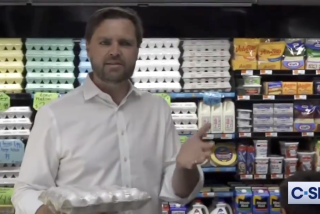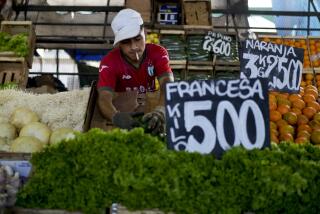South America : Prices Creep Up, but Brazil Says Inflation Is Beaten : High interest rates curb credit and slow economic recovery. Government says plan is on track.
- Share via
RIO DE JANEIRO — Brazilians have enjoyed a year of their country’s lowest inflation in more than two decades, but they are now paying the price in high interest rates and an economic slump.
The leftist opposition charges that the anti-inflation program is undermining the foundations of the economy. Government officials admit to problems, but they insist the program is working and will result in solid economic development.
Most Brazilians agree with the government, according to recent polls. In one published by the newspaper Folha de Sao Paulo, more than two-thirds expressed approval of anti-inflation policies.
In the past 12 months, compounded inflation has totaled 35%. That sounds like a lot, but in Brazil it is the lowest sustained level since the 1960s. And the cost of basic food necessities such as rice, beans, cooking oil and chicken has actually shrunk.
In the first half of 1994, before the current anti-inflation program took effect, prices were rising by more than 40% a month, or several thousand percent a year. Successive anti-inflation programs over the previous eight years had failed miserably, and Latin America’s largest economy seemed to be flailing in a monetary morass that discombobulated government finances, discouraged investment and distressed workers by constantly evaporating their buying power.
Then came Fernando Henrique Cardoso. As finance minister in 1994, he slashed government spending and laid the groundwork for replacing the discredited cruzeiro with a new currency called the real, loosely pegged to the U.S. dollar. After the tired cruzeiro was discarded and replaced by the real on July 1, 1994, prices suddenly stabilized.
Banking on the success of the “Real Plan,” Cardoso ran for president and won, defeating leftist candidate Luis Inacio (Lula) da Silva.
Cardoso’s popularity remains high, thanks in large part to the Real Plan. The economy grew by more than 5% in 1994, buoyed by second-half retail euphoria as consumers rushed to buy goods at newly stabilized prices.
Rapid growth continued in the first quarter of this year, but warning signs began flashing. The economy was overheating, and a new surge of inflation was feared. Also, a flood of imports was running up a trade deficit--$4.5 billion so far this year.
*
To dampen spending, the government raised interest rates sharply. At nearly 30% a year above inflation, the bloated rates have created a credit crisis for business owners, farmers and consumers. Retail sales have dropped dramatically.
To slow imports, authorities have raised tariffs on cars and other durable goods. While officials predict that trade surpluses will return before the end of the year, opponents warn that the country is headed for a financial fiasco like Mexico’s.
In a flurry of declarations marking the anniversary of the real, critics also complained about the interest rates and about prices that have stabilized at what they say are exorbitant levels. Former presidential candidate Lula said in a guest newspaper column that “consumers are approaching the limit of indebtedness, the economy is threatening to go into recession and high prices will weigh more heavily on the pocketbooks of workers.”
President Cardoso, speaking on the real’s anniversary, acknowledged that the high interest rates are “a disaster” for many people and companies, but he promised that they would be reduced as conditions permit. More recently, the president complained about unreasonable increases in rents and prices for services such as bus fares and medical care.
“That situation is reaching its limit,” he said. “It must be stopped.” However, he ruled out government-imposed price freezes.
Some economists say that the underlying cause of residual inflation is excessive government spending. They say Cardoso must make deeper budget cuts and speed up planned privatization of state corporations.
Finance Minister Pedro Malan has acknowledged that the government needs to do more to get its finances in order. He has promised tax and social security reforms, more privatizations, deregulation and “de-bureaucratization.”
(BEGIN TEXT OF INFOBOX / INFOGRAPHIC)
The Economic Roller Coaster
Brazil’s anti-inflation program that began last year has brought prices down, though wages and buying power remain low.
Minimum monthly wage: $111
Cost of loaf of bread: $1.37
Dozen eggs: 98 cents
Gallon of milk: $2.94
Gallon of gasoline: $2.16
Big Mac: $3.05
Inflation Trail
Consumer Price Index shows Brazil’s battle with inflation.
July, 1994: 6.08%
June, 1995: 1.82%
Source: Brazilian Institute for Geography and Statistics
More to Read
Sign up for Essential California
The most important California stories and recommendations in your inbox every morning.
You may occasionally receive promotional content from the Los Angeles Times.













